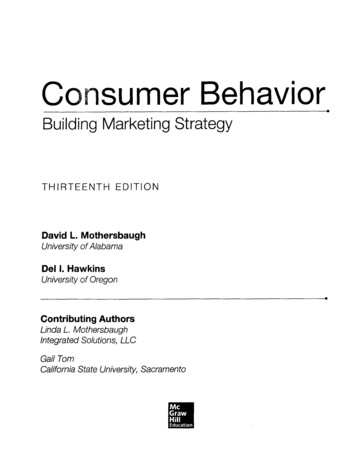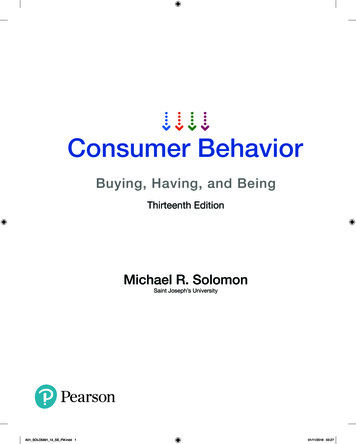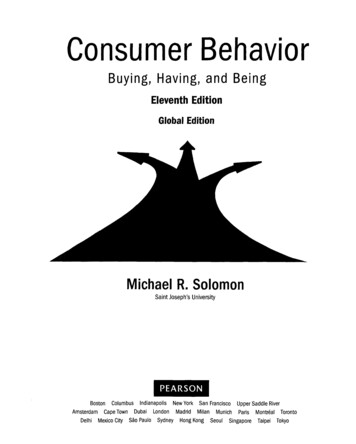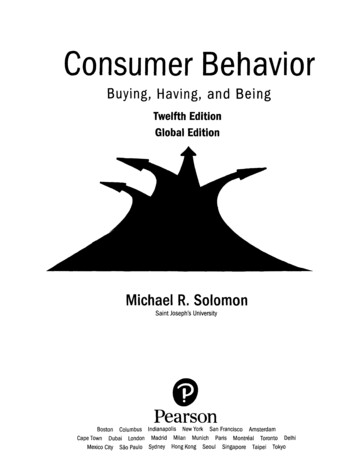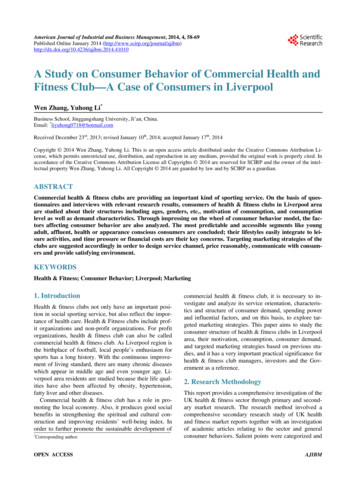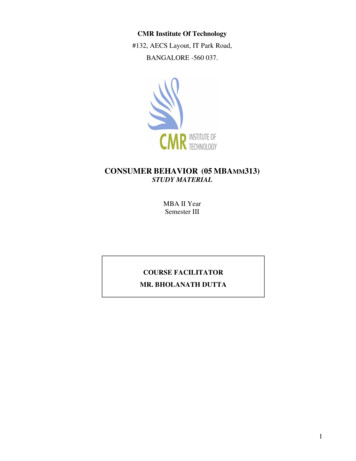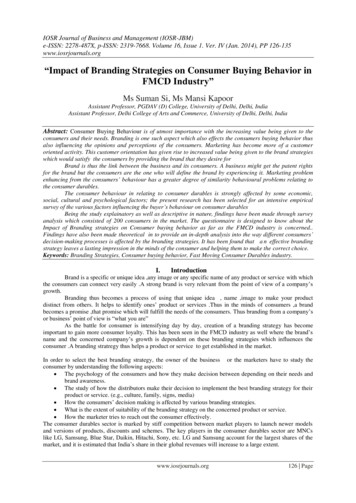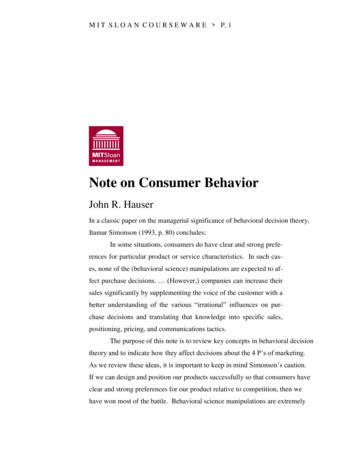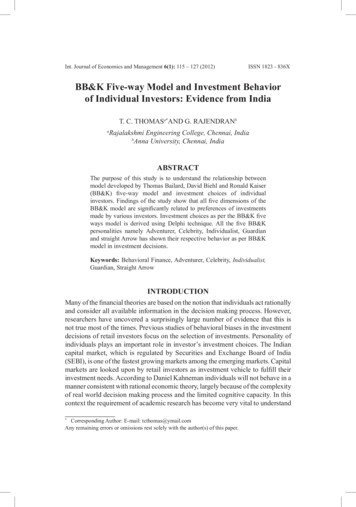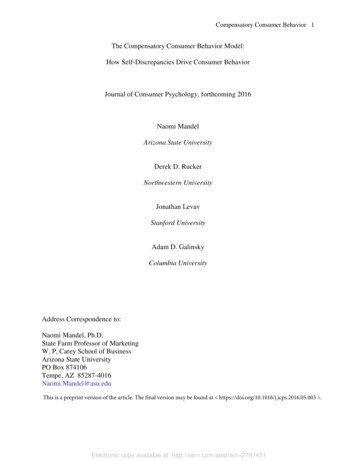
Transcription
Compensatory Consumer Behavior 1The Compensatory Consumer Behavior Model:How Self-Discrepancies Drive Consumer BehaviorJournal of Consumer Psychology, forthcoming 2016Naomi MandelArizona State UniversityDerek D. RuckerNorthwestern UniversityJonathan LevavStanford UniversityAdam D. GalinskyColumbia UniversityAddress Correspondence to:Naomi Mandel, Ph.D.State Farm Professor of MarketingW. P. Carey School of BusinessArizona State UniversityPO Box 874106Tempe, AZ 85287-4016Naomi.Mandel@asu.eduThis is a preprint version of the article. The final version may be found at https://doi.org/10.1016/j.jcps.2016.05.003 .Electronic copy available at: http://ssrn.com/abstract 2787451
Compensatory Consumer Behavior 2AbstractConsumer goods and services have psychological value that can equal or exceed theirfunctional value. A burgeoning literature demonstrates that one source of value emerges from thecapacity for products to serve as a psychological salve that reduces various forms of distressacross numerous domains. This review systematically organizes and integrates the literature onthe use of consumer behavior as a means to regulate self-discrepancies, or the incongruitiesbetween how one currently perceives oneself and how one desires to view oneself (Higgins,1987). We introduce a Compensatory Consumer Behavior Model to explain the psychologicalconsequences of self-discrepancies on consumer behavior. This model delineates five distinctstrategies by which consumers cope with self-discrepancies: direct resolution, symbolic selfcompletion, dissociation, escapism, and fluid compensation. Finally, the authors raise criticalresearch questions to guide future research endeavors. Overall, the present review provides botha primer on compensatory consumer behavior and sets an agenda for future research.Electronic copy available at: http://ssrn.com/abstract 2787451
Compensatory Consumer Behavior 3Consumption provides significant psychological value beyond the mere functional utilityoffered by products and services (Ariely & Norton, 2009; Arndt, Solomon, Gao, Wheeler, &Shiv, 2009; Kasser, & Sheldon; Rucker & Galinsky, 2008). Indeed, a pure functionalist accountcannot explain consumers’ purchases of items such as 250 blue jeans and 15,000 watches.Previous research has established a variety of deeper psychological motives for consumption,such as status signaling (Veblen, 1899), experiential pleasure (Holbrook & Hirschman, 1982),and extensions of the self (Belk, 1988). In this review article, we focus on understanding howconsumption helps people cope with self-discrepancies.A self-discrepancy is an incongruity between how one currently perceives oneself andhow one desires to view oneself (Higgins, 1987). For example, an individual can experience adiscrepancy between his or her desired ambition (e.g., to be the CEO of a Fortune 500 company)and realized position (e.g., currently a manager at a small regional company). Discrepancies canoccur in domains as varied as one’s intelligence, sense of power, or belongingness in a socialgroup. In this review, we present a theoretical model – The Compensatory Consumer BehaviorModel – to understand why a self-discrepancy triggers a motivation to reduce that discrepancy,and how this motivation leads to an identifiable set of consumer behaviors. We introduce theterm compensatory consumer behavior to indicate any purchase, use, or consumption of productsor services motivated by a desire to offset or reduce a self-discrepancy (Gronmo, 1997; Rucker& Galinsky, 2008; Woodruffe, 1997). Moreover, we discuss how self-discrepancies can bothincrease and decrease consumption behavior.In this review, we offer an integrative model to identify the sequence of steps throughwhich self-discrepancies produce downstream consequences on consumption. Whereas priorwork has reviewed the relationship between self-discrepancies and behavior broadly (e.g., Heine,
Compensatory Consumer Behavior 4Proulx, & Vohs, 2006), we emphasize— and identify for the first time— five distinct strategiesthat consumers use to cope with self-discrepancies. We begin by providing an overview of ourCompensatory Consumer Behavior Model (Section 1). Next, we review evidence suggesting thatdifferent sources of self-discrepancy affect consumer behavior (Section 2). Subsequently wediscuss the cognitive, affective, and physiological consequences of self-discrepancies that giverise to a motivation to reduce the self-discrepancy (Section 3). At the heart of our review, weintroduce, define, and provide evidence for five conceptually distinct strategies by which peopleuse consumer behavior to cope with self-discrepancies (Section 4). We next present evidencethat consumption can alleviate or reduce the negative psychological consequences of selfdiscrepancies (Section 5). With past research integrated into our Compensatory ConsumerBehavior Model, we introduce future research questions (Section 6). Finally, we discuss therelationship between our model and other models of psychological compensation (Section 7).Ultimately, this review is intended to serve as both a primer for those interested in understandingthe basic relationship between psychological self-discrepancies and consumer behavior, as wellas a catalyst for future research.1. Overview of the Compensatory Consumer Behavior ModelThe human psyche attempts to maintain stable levels of psychological assets related tothe self, such as self-esteem, belongingness, feelings of power, and feelings of control over one’senvironment (Crocker & Park, 2004; Kay et al., 2008; Leary et al., 1995; Whitson & Galinsky,2008). As part of this self-regulation process, individuals monitor the distance between theirpresent state (or actual self) and a goal state (or ideal self; Carver & Scheier, 1990; Higgins,1987).
Compensatory Consumer Behavior 5The potential for compensatory consumer behavior begins when a person perceives aself-discrepancy, or an inconsistency between one’s ideal and actual self (Higgins, 1987). Forexample, a person who fails an important test might view himself as unintelligent, and thusexperience a self-discrepancy between how he currently sees himself (i.e., unintelligent) and howhe wants to see himself (i.e., intelligent). Typically, an event occurs that either triggers a selfdiscrepancy (such as scoring poorly on a test) or that makes an existing self-discrepancy moresalient (such as being reminded about a recent failure). For instance, exposure to idealized (vs.average-looking) advertising models can increase the discrepancy between participants’ ratingsof their ideal and actual self-ratings (Sobol & Darke, 2014), social exclusion can increase thedistance between one’s actual and desired level of belongingness (Lee & Shrum 2012), andhaving fewer job offers than one’s peers can make one feel less competent than expected in one’scareer (Wicklund & Gollwitzer, 1981, 1982). In our framework, we refer to such events assources of self-discrepancy. Many previous researchers on this topic have not interpreted theirfindings explicitly in terms of self-discrepancy; in doing so, we synthesize and unify previouslydistinct findings (MacInnis 2011).Self-discrepancies have several important features. First, they can arise in a variety ofdomains (i.e., a skill set or area of competence), such as intelligence, sense of power, oraffiliation. Second, self-discrepancies are typically psychologically aversive (Higgins, 1987;Tesser et al., 2000). Third, due to the aversive nature of self-discrepancies, people are motivatedto engage in self-regulation efforts to restore their desired state. These self-regulation efforts canmanifest in different forms of consumer behavior. If compensatory consumer behavior issuccessful in addressing a self-discrepancy, it reduces the psychological discomfort created bythe discrepancy.
Compensatory Consumer Behavior 6Figure 1 depicts this sequential process. Once a self-discrepancy is activated, it canproduce affective, cognitive, or physiological consequences that motivate people to resolve thediscrepancy. The motivation to resolve the discrepancy can affect consumer behavior through atleast five distinct strategies. Finally, consumer behavior, particularly in the form of consumption,has the potential to reduce the self-discrepancy. Next, we provide a brief overview of theevidence supportive of the general phenomenon of compensatory consumer behavior.Subsequently, we review each stage of the process.Insert Figure 1 here2. Sources of Self-Discrepancy and Evidence for its Effects on Consumer BehaviorPrevious literature has identified several domains in which self-discrepancies can ariseand produce downstream consequences in the form of compensatory consumer behavior. Table 1provides a sample of the wide variety of self-discrepancies linked to compensatory consumerbehaviors in past research. In this section, we review evidence of compensatory consumerbehavior resulting from self-discrepancies related to one’s self-concept (e.g., one’s own skills,competence, or values), one’s perceived standing relative to others, or important groups tied tothe self.Insert Table 1 here2.1 Self-discrepancies Related to One’s Self Concept
Compensatory Consumer Behavior 7Receiving negative feedback on a dimension related to one’s self-concept or perceivingoneself as inadequate with respect to an internal standard is one source of self-discrepancy.Early findings on the effects of self-discrepancies on behavior originated from an effort tounderstand how self-discrepancies related to the self-concept guide people’s consumption habits.Braun and Wicklund (1989) found that first-year students at a university – who by virtue of theirfreshman status tend to be insecure about their identity vis a vis the university – listed owningmore university-branded clothing articles than did (presumably more secure) fourth-yearstudents. The authors replicated these correlational findings in two subsequent experiments, inwhich students who received negative feedback regarding their competence on an importantaspect of their identities were more likely to express a desire to visit “prestigious andfashionable” vacation destinations compared to control participants. More recently, Gao,Wheeler, and Shiv (2009) found that participants who felt insecure (vs. secure) about theirintelligence were more likely to choose a product related to intelligence (e.g., a fountain pen)over a product unrelated to intelligence (e.g., a candy bar). Elsewhere, researchers have shownthat self-discrepancies affect consumption with respect to one’s masculinity (Willer, Rogalin,Conlon, & Wojnowicz, 2013) and one’s sense of personal space (Levav and Zhu 2009).2.2 Self-discrepancies Related to One’s Standing Compared to OthersSelf-discrepancies can also arise from social comparison, in which an individualcompares his or her own standing on skills or dimensions relative to another, particularly whenmaking an upward comparison (to someone with superior skills; Mussweiler, 2003). Forexample, viewing images of thin models in advertisements can lower the ad viewer’s self-esteem(Richins, 1991). Such unflattering social comparisons may in turn produce compensatoryconsumer behavior. For example, feeling less powerful than others can lead consumers to report
Compensatory Consumer Behavior 8a higher willingness to pay for high-status products, in order to restore feelings of power (Rucker& Galinsky, 2008, 2009).In addition, because humans have a strong need to establish and maintain socialrelationships (Baumeister & Leary 1995), self-discrepancies can occur when individuals feelsocially excluded with regard to an important referent group. Several studies show that whenself-discrepancies arise in terms of one’s affiliation with others, people are more likely to buyproducts that signal status or membership in the social group (Dommer & Swaminathan 2013;Duclos et al., 2013; Lee & Shrum 2012; Mead et al. 2011; Wan et al, 2014, Wang et al., 2012).For example, Lee and Shrum (2012) found that consumers who were ignored, increased theirlevels of conspicuous consumption (in order to get noticed), whereas consumers who wererejected increased their donation behavior (in order to improve relational status).A self-discrepancy in relation to others can also happen when individuals feel that theirrelationship status is less than ideal. For example, Lastovicka and Sirianni (2011) suggest that afailure or loss of a romantic relationship can cause individuals to form strong attachments andeven feel love toward their personal possessions, such as automobiles. Here, the need toassociate the self with another person—coupled with an inability to do so—prompts consumersto fulfill the need for affiliation by forming relationships with brands and possessions.2.3 Self-discrepancies Related to One’s Social GroupsSocial identity is the part of the self that consists of group memberships, which canprovide an important source of self-esteem (Tajfel & Turner, 1979). A group’s identity may bedevalued or stigmatized by others, due to race, religion, or socioeconomic status (e.g., Crocker &Major, 1989; Dovidio et al., 2000), leading to a perception that the social group’s status is lessthan ideal. A negative value assigned to one’s group by other groups can foster a self-
Compensatory Consumer Behavior 9discrepancy between one’s actual and desired social identity, leading to compensatory consumerbehavior. For instance, Charles and colleagues (2009) reported that disadvantagedsocioeconomic racial groups spent a larger percentage of their income than other demographicgroups on conspicuous goods such as jewelry and cars (but not on nonvisible items), presumablyto counteract the perception of low status.An extreme example of a group self-discrepancy is one in which the dominant political,religious, or social system of an individual’s country is challenged (Jost, Banaji, & Nosek, 2004).For exa
Compensatory Consumer Behavior 1 The Compensatory Consumer Behavior Model: How Self-Discrepancies Drive Consumer Behavior Journal of Consumer Psychology, forthcoming 2016 Naomi Mandel Arizona State University Derek D. Rucker Northwestern University Jonathan Levav Stanford University Adam D. Galinsky Columbia University Address Correspondence to: Naomi Mandel, Ph.D.
